|
February
8
We heard lions calling in the night, and the soft rising whoop-whoop
sound of a hyena. We woke up before five to the whistling call of
the pearl-spotted owlet. The camp staff reported they saw a honey
badger in the early hours trying to raid the kitchen.
I
filled my cup from the coffeepot at the fire. Breakfast was at
5:30; no jungle oats like in winter, but the avocado on toast was
perfect. On the road by six o'clock - this was to be our schedule
for the whole trip.
Some
of our group were talking about things they hoped to see – a
leopard, a cheetah, perhaps wild dogs. Not wanting to make
demands, I told Gee I would be happy as long as we saw an impala
or a francolin (though I did secretly wish to see a leopard in a
tree).
|
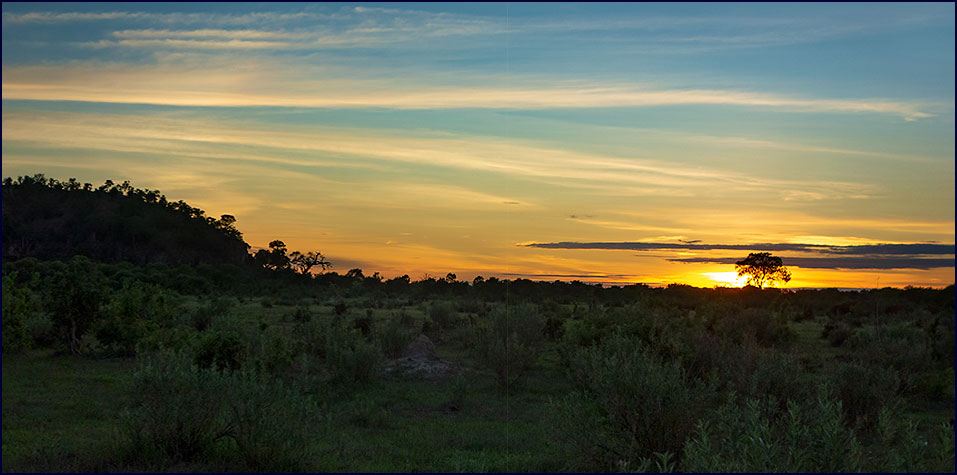
Sunrise near Leopard Rock
|
We were out in the bush when the sun came up, and the sky
was filled with streaks of dark clouds and fiery orange. A
Rufous-naped Lark serenaded us from a branch, singing his little
heart out in accompaniment of the dawn. A kori bustard stepped out
of the shadows into the early sunshine.
A bachelor herd of impala greeted the morning, their
chestnut coats glowing in the warm early light. They were trying
to get up the nerve to cross the road in front of us but seemed
skittish – dawn is a time when many of the predators are out
hunting.
A
tawny eagle kept watch from the top of a dead tree. The air was
filled with the background noise of cape turtle doves chanting; Bots-wa-na, Bots-wa-na.
Gee pointed out some hyena tracks in the sandy road. The sky was
clear and blue now. We scanned the plain for motion as we drove.
Around seven o'clock we passed King’s Rock, another big
outcropping, and we were heading toward Leopard Rock when we
caught a flash of chestnut movement across the plain. Suddenly we
saw a herd of about 15 impala, bounding and leaping toward us,
running for their lives. I barely had time to think, ‘It must be
wild dogs’ before we saw one of those fabulous canines streaking
at the heels of one of the impala, and another one close behind.
The impala herd split, and we lost sight of the impala and the
dogs.
|
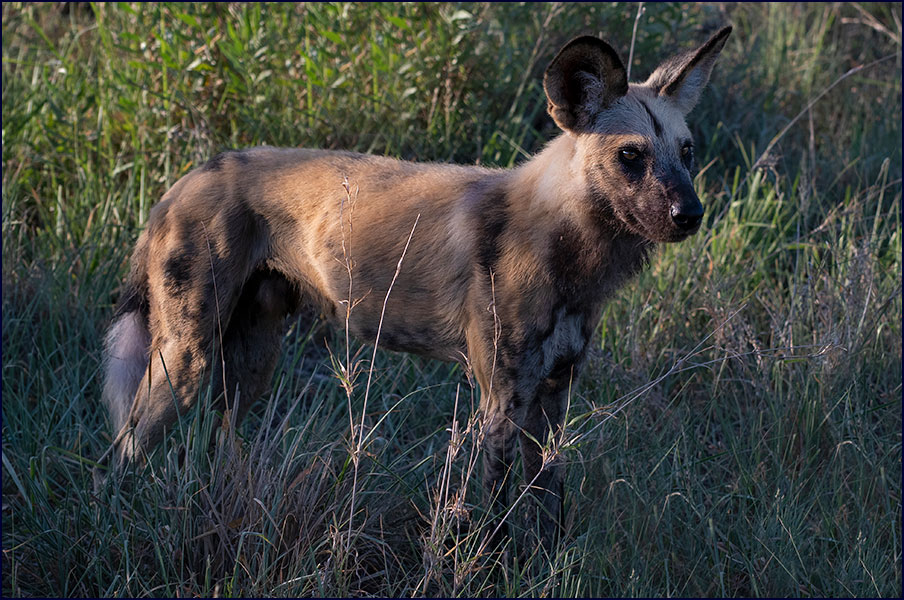
African Wild Dog |
Gee intuitively turned the vehicle in the opposite
direction than we expected and circled around through the brush.
As usual he knew just where to go; before long the two African
Wild Dogs trotted down the track in front of us. Soon a third dog
joined them; this one was younger, and he took a submissive pose
while chirping and trilling in a high pitched voice - apparently
he thought the others had killed and was begging them to
regurgitate some meat for him. Wild dogs are formidable hunters;
they hunt by sight and hearing, not scent, and they chase down
their quarry with relentless endurance. But it appeared that there
had not been a kill so far this morning so no breakfast was
forthcoming, regurgitated or otherwise. Soon all three dogs made
their way off through the bushes to rejoin the hunt.
We drove up the road ahead, hoping to see more action.
Before long two dogs came out of the bushes off to the right and
stealthily walked straight toward us. We could see the sun
gleaming on their brown, black and white patchwork coats. The wild
dogs have long lean bodies like a greyhound, huge ears,
shepherd-like muzzles and long sharp canine teeth. They walked
right up to our land cruiser and paused to look around, taking
little notice of us before continuing up the road. We left them to
their hunt.
We drove along the dry Savuti Channel, and Gee reminded us
that a famous BBC documentary about fishing leopards had been
filmed there. As the river was drying up and the catfish were
trapped in dwindling pools, several leopards in the area learned
to hunt these fish, leaping into muddy pools to catch them. On a
previous trip we had seen one of these fish-eating leopards curled
up sleeping in the dry riverbed.
A Coppery-Tailed Coucal looked down at us from a tree
branch; this largish bird is very striking with bold black, white
and coppery chestnut plumage and bright red eyes. We added the
Arrow-marked Babbler and the White-browed Sparrow Weaver to our
bird list. A Brown Snake Eagle took flight from his perch in a
dead tree as we approached; Gee told us that as they have bare
legs they are not considered true eagles, which always have
feathered legs.
|
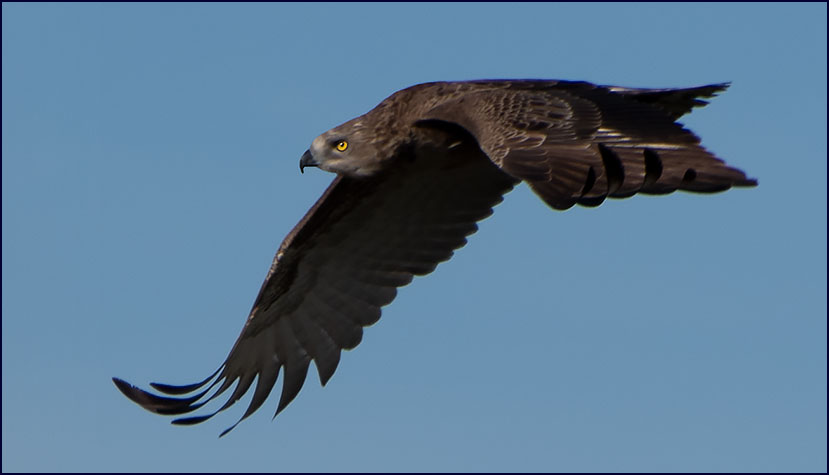
Brown Snake Eagle |
Gee drove us along the edge of the Savuti Marsh. Suddenly
we noticed several colorful birds following the land cruiser,
swooping back and forth to catch the insects that fly up out of
the grass in front the vehicle. They were Carmine Bee-eaters, a
bird I had not seen on previous trips. These beautiful birds are a
deep chestnut-red color with scarlet throats, iridescent
dark-green heads with black eye masks, and light blue on their
backs that is only visible in flight.
|
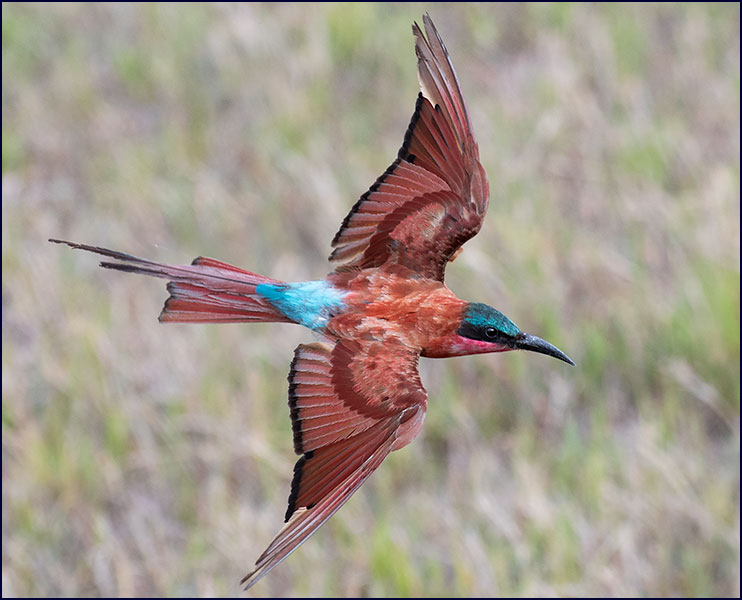
Carmine Bee-eater
|
As
we continued across the marsh more and more of the bee-eaters flew
along beside the land cruiser, swooping, diving and crisscrossing
all around us. Their vivid red and blue plumage shone brilliant in
the sunlight. I spent a lot of time trying to photograph them; it
was difficult to get the auto-focus to lock on because they moved
so quickly. But in the end I got some good shots, including one
where you can see the bird actually catching a bee in its beak.
We scanned the wide open plain for a glimpse of a cheetah,
but with no luck. Gee pointed out a dark dot far across the plain
and told us it was a Roan Antelope.
His ability to identify animals from a huge distance is
amazing. Gee changed course and moved carefully toward the
antelope. He told us, “I had planned to go the other way, but
the animals are driving us this way.”
The
roan antelope was wary so we could not get too close, but we did
get near enough for a better look. Large and handsome, he was
brownish-grey with black and white markings on his face and short
backwards-curving horns. I was excited to see the roan; they are
rare and quite shy, and I had never seen one before.
We came to the far side of the dry marsh and drove through
an area of dead trees that had grown during the time the channel
was not flowing, but then drowned with the water temporarily
filled the marsh again. Their bare limbs reached up to the sky
like grasping hands.
To
our delight we say a Meyers Parrot sitting on the top of a bush
with a Go-away Bird. Gee paused to point out honey badger tracks
and a centipede trail in the sand road.
|
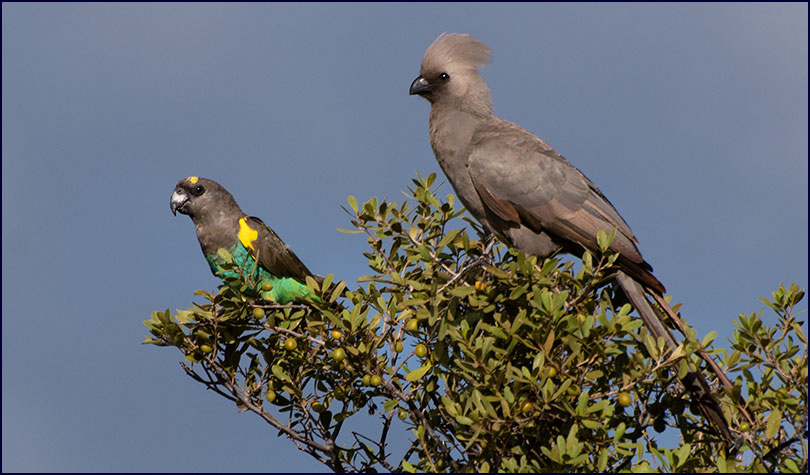
Meyers Parrot and Go-away Bird
|
We came to Rhino Pan, a man-made water hole with a solar
powered pump. As we were in the rainy season there were waterholes
everywhere, but the pump is vital in the dry season, especially
for the elephants. As nature made them, elephants would migrate,
following the water sources with the change of seasons – but as
most of their habitat has been lost and they can no longer travel
across the continent like they used to, water sources must be
provided for them within the Park’s boundaries. This encourages
them to stay in the park as well as helping them survive the
droughts.
A
big bull elephant walked by the solar pump and came to the water
hole. He drank for a long time, swaying gently from side to side
as he sucked up water by the gallon with his trunk and squirted it
into his mouth. He seemed relaxed and serene.
Soon
a second big male joined him; this one looked dark, almost black
in color, because he was covered with wet mud. He seemed to be
agitated - Gee said he might be in musth. He told us that females come into estrus once a year, but the
males go into musth
twice a year - that sounds like a recipe for frustration to me.
Observing the wet muddy bull, Gee said, “See, his brain is
dripping.”
We sat by the waterhole watching for a while. A small
bachelor herd of impala wandered by; several of the young males
locked horns in fighting practice. Half a dozen Amur Falcons
circled above us, small pretty birds of prey sailing on the breeze
to hunt for bugs. A group of banded mongoose scurried about and a
pair of spurwing geese flew overhead. The musth
elephant stalked off across the plain angrily, tusks held high and
tail wringing. He flapped his ears and waved his trunk about for
effect.
We
stopped for tea around nine. We
reflected on how much we had seen already this morning. Mary
pondered, “I wonder what
will happen next?”
|
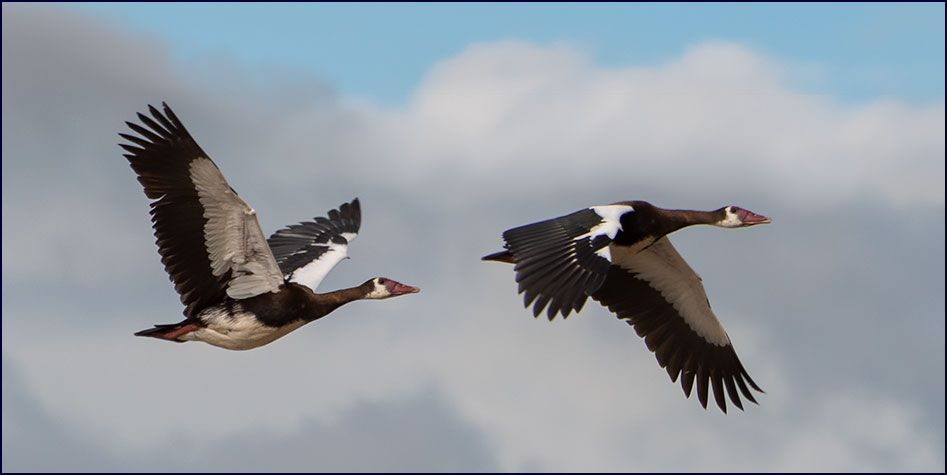
Spurwing geese
|
We skirted through a wooded area at the edge of the dry
marsh. For a while the air was hot, but soon the breeze picked up
and the clouds rolled in, and the air felt amazing.
A pair of warthogs crossed the road in front of us and then
turned to regard us suspiciously. Caked with mud, they looked a
bit absurd with their sparse coats, course manes, curved tusks and
the knobby protuberances on their faces for which they are named.
Tara spotted two honey badgers, but they disappeared
quickly into the bushes before we could get a good look. But then
a bit further on she spotted movement off to the right and asked
Gee to stop – sure enough it was another honey badger. This one
was covered with wet oozy mud; Gee said he had been in a wallow.
His normally silvery-white back was almost black with slick mud,
and the only visible white on him was the top of his head. Gee
pulled closer and we watched as he bustled around, scratching in
the dirt and looking for food. He did not pay any attention to us
being there. A good spot by Tara; we dubbed her the badger queen.
|
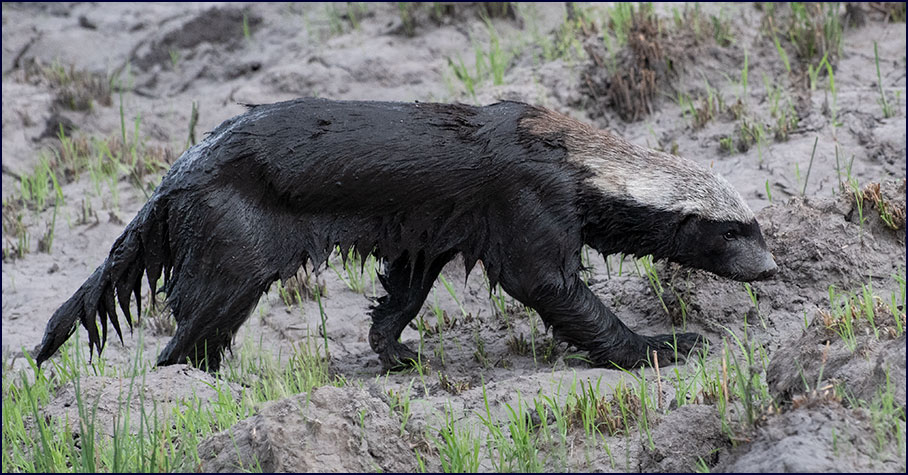
Honey Badger
|
A Black-backed Jackal stood looking at us intently; this
beautiful member of the dog family was a chestnut color with a
silvery-black back and a foxlike head. Several more of them
trotted through the tall grass. Gee said that the jackals will
make alarm calls when they see lions, which alerts the herbivores;
therefore the lions will kill them if they get the chance.
|
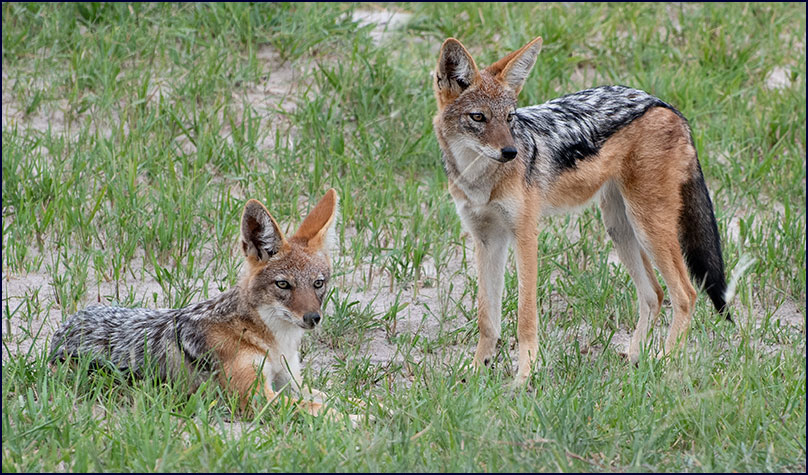
Black-backed Jackals
|
We noticed a lovely giraffe drinking at a waterhole. He had
just a short stump of a tail; Gee said a lion took the rest of it.
Further off we could see a herd of Plains Zebras; one of them had
a fairly young baby, but they were far from the road so we could
not get close.
Along
the edge of the marsh we spotted yet another honey badger; that
made it four for the day, plus the one the staff saw in camp that
morning. We were surprised to see so many honey badgers; they are
generally elusive and you have to be lucky to see one.
We stopped back by Rhino Pan; we learned the solar-powered
waterhole is so named because rhinos used to hang out there years
ago. A waterbird convention was going on; the ones we had seen
earlier were all still there, and they had been joined by dainty
little ducks with bright blue beaks called Hottentot Teal, as well
as their cousins, the Red-billed Teal. An
African Spoonbill waded along, hoovering his shovel-like bill back
and forth under the water to see what he could spoon up for lunch.
|

African Spoonbill with Red-billed Teal.
|
Three giraffes walked alongside the road for a ways,
stopping occasionally to peer at us. One of them lowered himself
awkwardly down to drink from a puddle, splaying his long legs out
wide to be able to reach the ground - this definitely seemed like
a design flaw. A very large warthog stood in a mud hole staring at
us, his lower half dark with a coating of wet mud. A Yellow-billed
Kite was flying above and we got a look at an interesting ground
bird with the absurd name of Spotted Thick-knee.
We got back to camp about 12:30 for lunch, showers and a
little relaxation time. We were back out on safari by 2:30 pm.
This is the great thing about having our own private group on a
camping safari; Gee was willing to take us game driving for as
long as we wanted. Often at the lodges they take you on a morning
game drive for a couple of hours, and then another short late
afternoon drive – and the rest of the time you sit around camp.
None of that for us; we were all very keen to do and see as much
as possible. We were spending 10 to 12 hours per day out on
safari; this made it a great experience for us, but I worried that
we were working poor Gee to death.
|
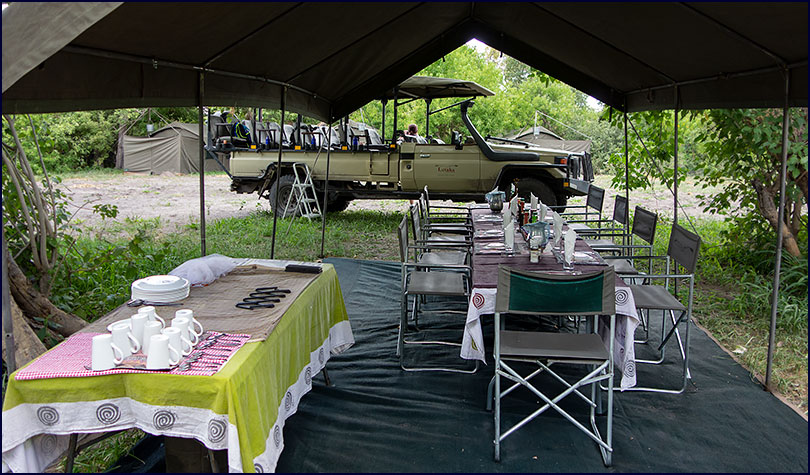
Our dining room |
The land cruiser took several tries to start that
afternoon, and it sounded a little rough. It was raining lightly
as we set off. Our camp was right by the Savuti Channel so we
drove along the dry riverbed each time we set out. A short ways
from camp we came upon a big giraffe right in the road. He moved
over a few meters to let us by, but we stopped to watch him close
up. He was very old and thin, and had scars on his legs, probably
from lions. Gee said the giraffe’s main defense is to kick; they
can kick with all four legs, forward, backwards and sideways. When
lions come a giraffe does not run, he kicks.
We could see an impressive storm
on the horizon; there was a dark mushroom-shaped cloud with rain
streaming down in the middle. Four go-away birds sat on top of a
tree; one of them gave its signature Go
Away call in a petulant voice, sounding like an old hag
telling us to get lost.
At the Elephant Spa waterholes a mother Egyptian goose led
her brood of seven babies out of the water and along the shore. We
noticed a strange looking white blob that like a Styrofoam ball
about two feet above the water at the edge of pan; Gee told us it
was the nest of a Foam-nest Frog. They lay their eggs in the foam,
which is poisonous to other animals. When the babies hatch they
jump down into the water.
Before long two bull elephants came in to drink.
They silently strode down to the water’s edge, scattering
the blacksmith lapwings that stood by the pan, and drank in a
dignified manner, taking their time. When the elephants visit the
waterholes it always seems somewhat of a ritual; they are not
there just to quench their thirst, but to enjoy the surroundings
and each other’s company. Sort of like stopping off at a pub
with friends for a drink.
|
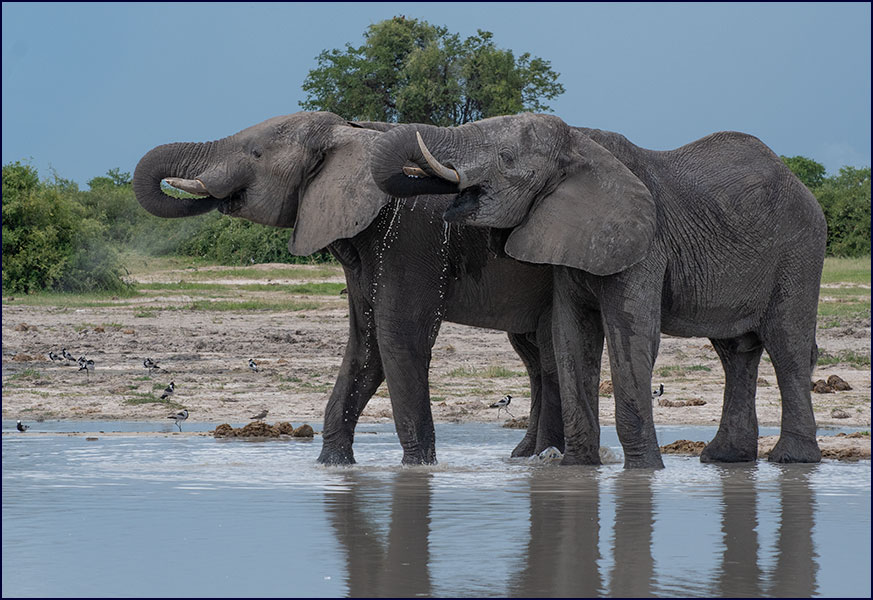
The Elephant Pub |
Then the giraffes arrived one by one, seven of them
altogether. One of them was heavily pregnant. Gee told us that
giraffes have a 14 month gestation period, where lions are only
three and a half months.
In
contrast to the relaxed demeanor of the elephants, drinking is a
dangerous time for giraffes, and they approach this necessary
ordeal with trepidation. When they spread out their legs and lower
themselves to drink they are most vulnerable to attacks by lions.
Whenever possible giraffes drink at small puddles in the open, and
avoid deep waterholes with trees and bushes that would conceal
predators. This group stood scanning their surroundings for a long
time, looking and waiting nervously before finally lowering
themselves to drink. They repeatedly startled at some noise or
imagined threat, leaping back up tall to scan some more.
As usual we were surrounded by birds; some of the notable
new ones were the Red-billed Fire Finch, the tiny Kitlett, and a
Ruff in its white phase. A beautiful pair of Little Bee-eaters sat
on a branch; green with bright yellow throats, orange breasts and
iridescent turquoise eye shadow, they were camouflaged against a
background of green leaves.
|
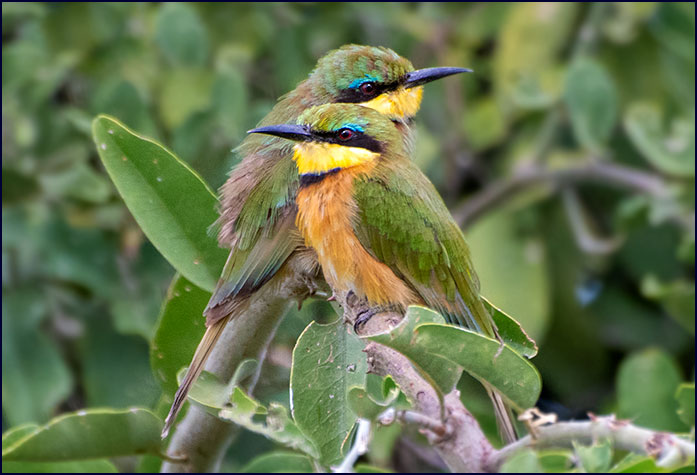
Little Bee-eaters
|
Two black-backed jackals hung out near the road; I loved
their refined features and bright expressions. It seemed we were
seeing them much more often than on previous trips. Many people
have a negative association with jackals; to my mind, these
beautiful creatures have an undeserved bad reputation.
We spent some time watching a herd of impala that had quite
a few babies. The youngsters have exquisite faces with large dark
eyes, huge ears, and refined muzzles; the boys have little spike
horns. We saw a mother impala nursing a very small baby.
|
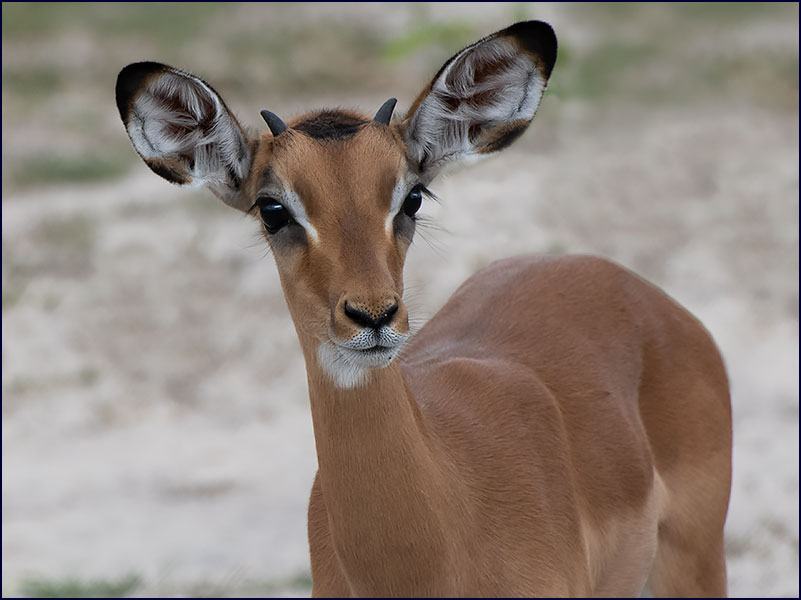
Baby impala
|
An
African harrier hawk was trying to rob a hornbill nest in a dead
tree; it flapped its wings for balance as it tried to stick its
head into the tree holes. The father hornbill was going crazy,
squawking and diving at the hawk trying to protect the nest.
A dainty steenbok with one broken horn turned his butt to
us and took off when we approached; you have to be quick to get a
photo of these tiny antelopes. They are tiny and delicate viewed
from the side, but when seen from behind appear surprisingly
round. It must be hard to be a steenbok in Africa; you would be
everybody’s idea of a good lunch.
|
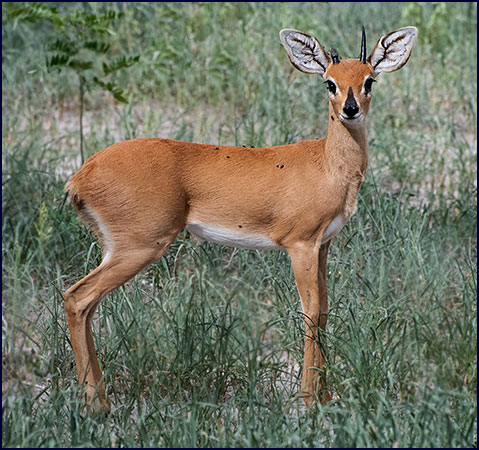
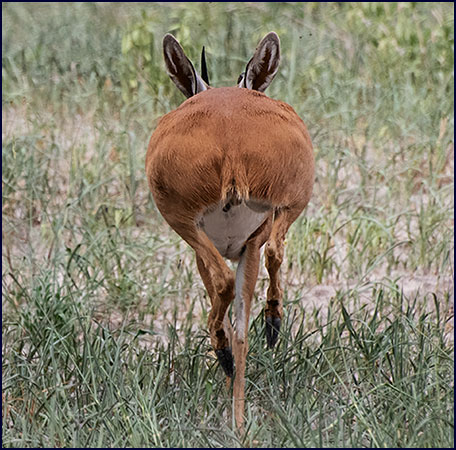
Steenbok
|
Another interesting new bird was the Levaillant’s Cuckoo;
he was largish, glossy black with a green sheen, and had a large
ragged topknot.
We
passed near a charismatic kori bustard; these huge birds also seem
to be much more plentiful in the rainy season - we had been seeing
them everywhere. We got quite close to an exquisite female
Red-crested Korhaan, a fair-sized bird though smaller than the
bustard. The beautifully patterned feathers on her back and large
expressive eye made her extremely photogenic.
|
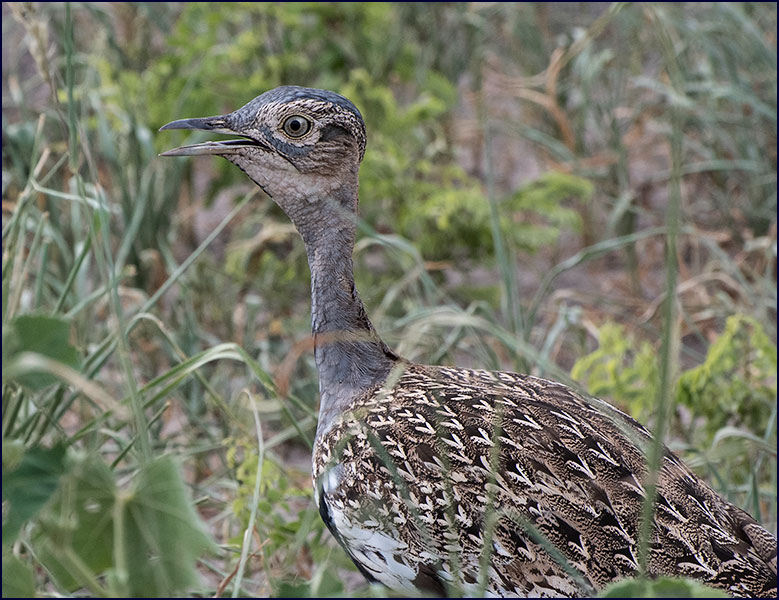
Red-crested Korhaan |
A greater kudu mom was hiding in the trees with her
several-month-old calf; the baby looked like a miniature replica
of his mom, unlike the wildebeest and tsessebe babies who were a
completely different color. A bit later we passed a large kudu
bull, most likely the father.
On each drive we saw many more birds and
animals than I am reporting here, and some of the more common ones
we saw every time. In the interest of preventing this narrative
from being too long and boring I am sticking to the more notable
sightings.
We
took a deep sand road; we saw far less of these in the rainy
season because the damp sand was packed, where in winter it is dry
and loose. We were driving up the Savuti Channel again, but at a
point far away from camp. The riverbed was wider here, and the
perspective was odd - it felt like we were going uphill when we
were not. I recognized that this was the spot where I had decided
to visit in the rainy season; now I realized that the flowing of
the river was not controlled by the rains, but rather by whatever
mysterious Teutonic factors determined when the Savuti Channel
flowed.
A
huge African Buffalo was walking up the riverbed, and the road
took us quite close to him. He stopped and looked at us, chewing
some grass and eyeing us with disfavor. He was covered with dried
mud, and a single oxpecker sat on his back.
|
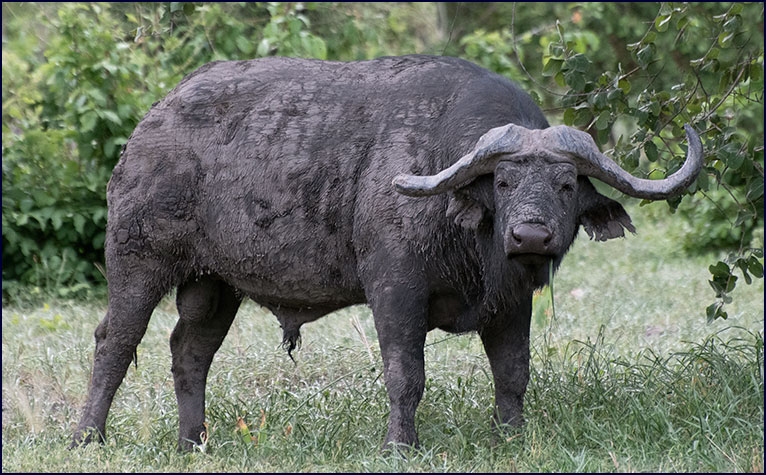
African Buffalo
|
A bit further on we found a lone wildebeest, no doubt
watching over his territory. It seemed a lonely existence; he
would have a herd of females but hardly ever spend time with them.
We admired his silvery coat and streaky black stripes, and his
thick, course black mane on both the top and bottom of his neck.
He was immaculately well-groomed and clean, at least in comparison
to the buffalo.
We
stopped by the hyena den; we had seen babies here last time, but
now nobody was home. We paused to watch a tree squirrel run up and
down the trunk of a big mopane. Gee picked a wild cucumber to show
us; it was about the size of a fist, green and prickly. Ostriches
eat them whole; they can get enough moisture from these fruits
that they don’t need to drink water.
We came upon a Tsessebe Day Care center. Several tsessebe
mothers were watching over half a dozen caramel-colored babies
just a few months old. Again we were struck by the color
difference between the blondish babies and the dark purply-brown
moms. We stopped to watch some more giraffes; I never tire of
watching these graceful, gentle creatures.
|
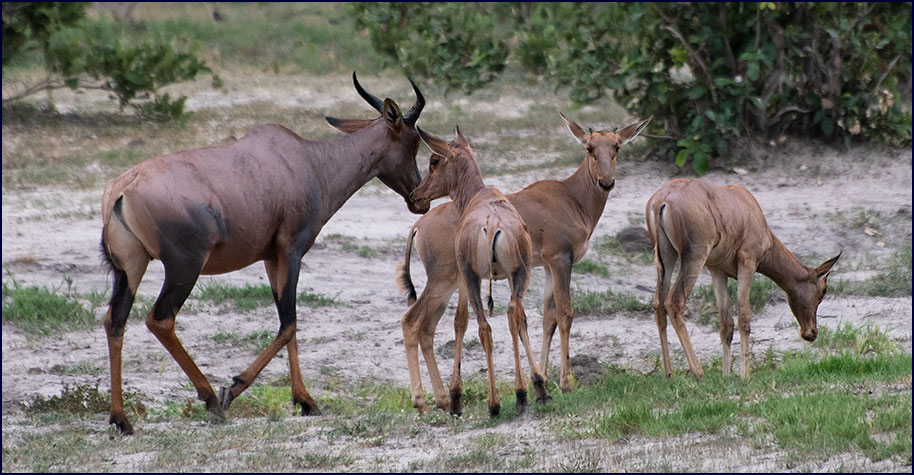
The Tsessebe Day Care Center
|
We were delighted when Gee found a Pearl-spotted Owlet
sitting in a tree. These tiny owls are only about six inches tall,
and have rounded heads with no visible ear tufts. They have two
black marks that look like eyes on the back of their heads. We
often hear their call of ascending whistling notes in camp, so we
were excited to get to see one of these little beauties. A Gabar
goshawk sat in a tree, a gorgeous small bird of prey. And a bit
further on we saw another pearl-spotted owlet – we were able to
get even closer to this one.
|
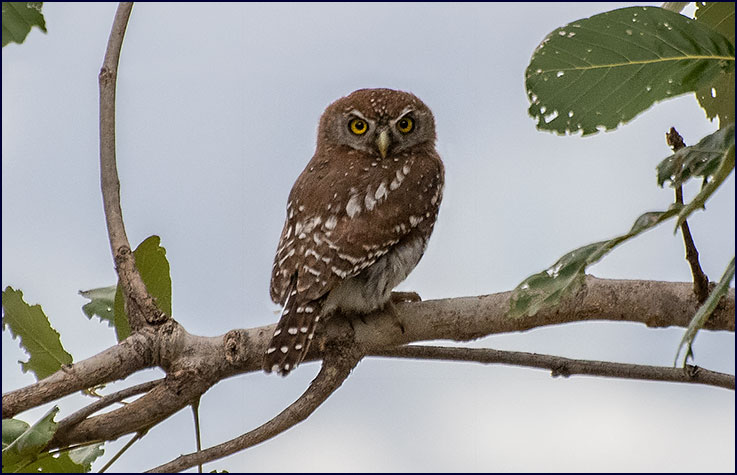
The tiny Pearl-spotted Owlet
|
Leopard’s Rock stood tall against a darkening stormy sky
as we headed back toward camp. A juvenile tawny eagle stood in
silhouette on a dead tree, his plumage pale, almost white.
It
was a spectacular sunset. The fiery light of the lowering sun
broke through the black storm clouds in the distance, making the
clouds glow. We could just barely see a herd of wildebeest in the
foreground, grazing in the dim light. A lone elephant hurried
across in the gathering dusk.
|
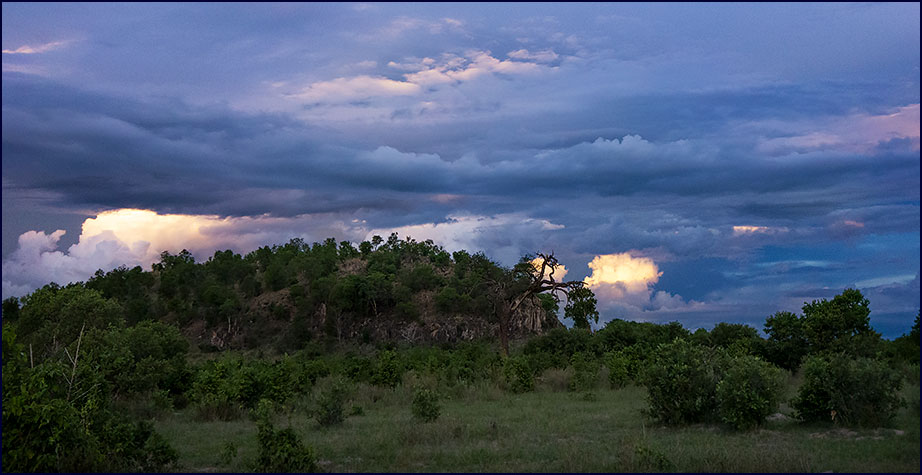
Savuti Sunset
|
The campfire merrily blazing in the near darkness welcomed
us back to camp. We had gin-and-tonics and wine as we sat in the
camp chairs and gazed at the fire - BD called it ‘bush
television.’ It had
been a fabulous day.
Life
announced dinner, and we sat down to a lovely meal. We noticed a
little statue of a bicycle decorated our table. We had seen only
one other vehicle the whole day, with just one guest in it – one
of the perks about visiting during low season. At dinner Gee got a
radio call saying that the other vehicle didn’t make it back to
their camp. He set out to try to find them after dinner, but by
the time he got close they had gotten back to camp.
We
could here lions roaring in the night, closer than before.
|